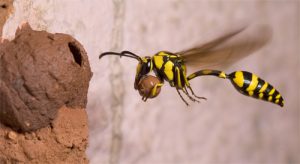
Potter wasp – Credit: Natasha Mhatre
Don’t you love neighbours who always lend a helping hand? We’ve been learning about the environment, communities and how organisms depend on each other for their survival in class. It’s a real joy to observe an organism in action on my balcony! When we think about beneficial insects that live in our area, the wasp would most likely not make the list. The first thing that comes to people’s minds is that they have the potential of delivering painful stings. Well, that is true, but did you know that the wasp is a beneficial insect that provides natural control of many types of caterpillars and even some beetle larvae?
I’ve had the privilege of having such a fascinating insect in my balcony recently. While working next to the plant I’ve placed out in the balcony, I noticed this curious little thing visiting my plant in 5 minute intervals. I knew it was a wasp and it feeds on flower nectar or on other insects, but my plant didn’t have any flower and I was rather certain that it was insect-free. I was baffled and was determined to find out what this little fellow was up to. Turns out, the wasp that visits my plant tirelessly, is known as the Potter Wasp.
Potter Wasps belong to the family Vespidae, subfamily Eumeninae. They are related to Mud Daubers. Like Mud Daubers, these wasps are solitary, and are beneficial in that they hunt for caterpillars to paralyze and place in a brood cell, i.e. the clay-based compartment in which the wasp larva develops. It never ceases to amaze me at the variety of adaptations used by insects to survive. In the case of the Potter wasp, each brood cell is provisioned with 1 to 12 caterpillars. The caterpillars are paralyzed with the wasp’s sting and serve as the only source of food for the developing young. The female wasp then lays a single egg, which is attached to the top inner surface of the brood cell.
The busy wasp in my balcony was a female potter wasp. It visited my plant unwearily to collect material to construct the clay-based brood cells. I am unable to see the home this potter wasp is building, but it should look like the one in the picture below. Hey kids, we’ve been learning about organisms being interdependent. In this case.. I’m providing the materials for the wasp to build its home, while it keeps pests away from my plants! heehee!



Potter wasp – Credit: Natasha Mhatre
Don’t you love neighbours who always lend a helping hand? We’ve been learning about the environment, communities and how organisms depend on each other for their survival in class. It’s a real joy to observe an organism in action on my balcony! When we think about beneficial insects that live in our area, the wasp would most likely not make the list. The first thing that comes to people’s minds is that they have the potential of delivering painful stings. Well, that is true, but did you know that the wasp is a beneficial insect that provides natural control of many types of caterpillars and even some beetle larvae?
I’ve had the privilege of having such a fascinating insect in my balcony recently. While working next to the plant I’ve placed out in the balcony, I noticed this curious little thing visiting my plant in 5 minute intervals. I knew it was a wasp and it feeds on flower nectar or on other insects, but my plant didn’t have any flower and I was rather certain that it was insect-free. I was baffled and was determined to find out what this little fellow was up to. Turns out, the wasp that visits my plant tirelessly, is known as the Potter Wasp.
Potter Wasps belong to the family Vespidae, subfamily Eumeninae. They are related to Mud Daubers. Like Mud Daubers, these wasps are solitary, and are beneficial in that they hunt for caterpillars to paralyze and place in a brood cell, i.e. the clay-based compartment in which the wasp larva develops. It never ceases to amaze me at the variety of adaptations used by insects to survive. In the case of the Potter wasp, each brood cell is provisioned with 1 to 12 caterpillars. The caterpillars are paralyzed with the wasp’s sting and serve as the only source of food for the developing young. The female wasp then lays a single egg, which is attached to the top inner surface of the brood cell.
The busy wasp in my balcony was a female potter wasp. It visited my plant unwearily to collect material to construct the clay-based brood cells. I am unable to see the home this potter wasp is building, but it should look like the one in the picture below. Hey kids, we’ve been learning about organisms being interdependent. In this case.. I’m providing the materials for the wasp to build its home, while it keeps pests away from my plants! heehee!





